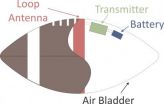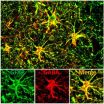(Press-News.org) Referees may soon have a new way of determining whether a football team has scored a touchdown or gotten a first down. Researchers from North Carolina State University and Carnegie Mellon University, in collaboration with Disney Research, have developed a system that can track a football in three-dimensional space using low-frequency magnetic fields.
The technology could be particularly useful for situations when the ball is blocked from view, such as goal-line rushing attempts when the ball carrier is often buried at the bottom of a pile of players. The technology could also be useful for tracking the forward progress of the ball, or for helping viewers follow the ball during games with low visibility – such as games played during heavy snow.
Previous attempts to design technology that tracks the position of a football have used high frequency radio waves. But these high frequency waves are absorbed by players and can be thwarted by the complex physical environment of a football stadium. Because the technology would be most useful in pile-ups, when the ball is obscured by players, these high-frequency approaches aren't practical – the absorbed radio waves would result in incorrect or incomplete data on where the ball is located.
"But low frequency magnetic fields don't interact very strongly with the human body, so they are not affected by the players on the field or the stadium environment," says Dr. David Ricketts, an associate professor of electrical and computer engineering at NC State and senior author of a paper describing the research. "This is part of what makes our new approach effective.
The researchers designed and built a low frequency transmitter that is integrated into a football, and is within the standard deviation of accepted professional football weights. In other words, the football that has the built-in transmitter could be used in a National Football League game. Antennas, placed around the football field, receive signals from the transmitter and track its location.
But the researchers also had to address another complicating factor.
When low frequency magnetic fields come into contact with the earth – such as the playing surface – the ground essentially absorbs the magnetic field and re-emits it. This secondary field interacts with the original field and confuses the antennas, which can throw off the tracking system's accuracy.
"We realized that we could use a technique developed in the 1960s called complex image theory," says Dr. Darmindra Arumugam, lead author of the paper and a former Ph.D. student at Carnegie Mellon now at NASA's Jet Propulsion Laboratory. "Complex image theory allows us to account for the secondary fields generated by the earth and compensate for them in our model."
"We're still fine-tuning the system, but our goal is to get the precision down to half the length of a football, which is the estimated margin of error for establishing the placement of the football using eyesight alone," Ricketts says.
INFORMATION:
The paper, "Three-Dimensional Position and Orientation Measurements using Magnetoquasistatic Fields and Complex Image Theory," was published online in June in IEEE Antennas and Propagation Magazine. Co-authors include Dr. Dan Stancil, head of NC State's Department of Electrical and Computer Engineering; and Dr. Joshua Griffin, formerly of Disney Research. The research stems, in part, from previous work done by the researchers while at Carnegie Mellon, with funding from Disney Research.
Crossing the goal line: New tech tracks football in 3-D space
2014-06-13
ELSE PRESS RELEASES FROM THIS DATE:
Breakthrough for information technology using Heusler materials
2014-06-13
It is the breakthrough that physicists and chemists around the world have long anticipated and it will play a pivotal role in information technology in coming years. Researchers at Johannes Gutenberg University Mainz (JGU) have managed, for the first time, to directly observe the 100 percent spin polarization of a Heusler compound. Heusler alloys are composed of several metallic elements arranged in a lattice structure. They are among those materials that potentially can be used for ever smaller data storage components with ever greater storage capacity. However, doubts ...
Rescue of Alzheimer's memory deficit achieved by reducing 'excessive inhibition'
2014-06-13
A new drug target to fight Alzheimer's disease has been discovered by a research team led by Gong Chen, a Professor of Biology and the Verne M. Willaman Chair in Life Sciences at Penn State University. The discovery also has potential for development as a novel diagnostic tool for Alzheimer's disease, which is the most common form of dementia and one for which no cure has yet been found. A scientific paper describing the discovery will be published in Nature Communications on 13 June 2014.
Chen's research was motivated by the recent failure in clinical trials of once-promising ...
Genotyping can predict disease outcomes in rheumatoid arthritis patients
2014-06-13
New cohort studies presented today at the European League Against Rheumatism Annual Congress (EULAR 2014) have shown the amino acid valine at position 11 of HLA-DRB1 gene to be the strongest independent genetic determinant of radiological damage in rheumatoid arthritis (RA).1 In addition, positions 71 and 74 were found to represent independent predictors, with the three positions together: 11, 71 and 74 strongly associated with disease outcomes.1
According to lead author Dr Sebastien Viatte of the Arthritis Research UK Centre for Genetics and Genomics, Manchester, United ...
Higher health care cost burden of musculoskeletal conditions compared to other diseases
2014-06-13
A new study presented today at the European League Against Rheumatism Annual Congress (EULAR 2014) highlights the increased health care costs associated with musculoskeletal conditions compared to other diseases. Health care costs were almost 50% higher for people with a musculoskeletal condition compared to any other singly occurring condition.1
This disparity remained high where two conditions co-existed, with health care costs still one third higher (36%) for those people with one of their two conditions musculoskeletal in nature, highlighting the significant impact ...
Sjögren's Syndrome significantly increases risk of heart attack
2014-06-13
A new study presented today at the European League Against Rheumatism Annual Congress (EULAR 2014) showed a significantly increased risk of heart attack in patients with Sjögren's syndrome (SjS), particularly in the first year following diagnosis. There was also a trend towards an increased risk for stroke.
SjS is an auto-immune inflammatory disease where the body's immune system attacks glands that secrete fluid, such as the tear and saliva glands.2 Inflammation within the glands reduces fluid production causing painful burning in the eyes, dry mouth, and sometimes dryness ...
Biomarkers predict long-term outcomes in juvenile idiopathic arthritis
2014-06-13
Data presented today at the European League Against Rheumatism Annual Congress (EULAR 2014) demonstrate the possibility of using biomarkers (developed from whole blood gene expression profiles) in children with juvenile idiopathic arthritis (JIA) to predict the status of their disease at 12 months. The long-term disease status at 12 months was accurately predicted only after treatment had been initiated, in newly diagnosed patients.1
JIA is the most common childhood* chronic rheumatic disease,2 affecting 16-150 children in every 100,000. As indicated by the name, the ...
Tamoxifen-resistant breast cancer reversed when drug paired with anti-malaria agent
2014-06-13
WASHINGTON — The inexpensive anti-malarial drug hydroxychloroquine (HCQ) reverses resistance to tamoxifen, a widely used breast cancer drug, in mice.
In the June 15 issue of Clinical Cancer Research, investigators from Georgetown Lombardi Comprehensive Cancer Center say adding HCQ to tamoxifen could provide a new treatment option for some women with advanced, postmenopausal estrogen receptor-positive (ER+) breast cancer. The ER+ subtype accounts for an estimated 70 percent of all breast cancers. While many of these women are treated with tamoxifen, which blocks estrogen ...
New research shows Western Amazon under threat from oil pollution
2014-06-13
A new study of pollution records indicates that the Western Amazon, an area of unparalleled biological and cultural diversity, may have been contaminated by widespread oil pollution over a 30-year period. This work will be presented at the Goldschmidt conference in Sacramento, California
Most of the world's tropical rainforests contain oil and gas reserves. Oil production started in the Western Amazon in the 1920s and peaked in the 1970s, but current growing global demand is stimulating a renewed growth in oil and gas extraction. Nearly 70% of the Peruvian Amazon was ...
Study shows gut microbe composition different in young children with and without type 1 diabetes
2014-06-13
New research published in Diabetologia (the journal of the European Association for the Study of Diabetes) shows that children diagnosed with type 1 diabetes have a less balanced composition of gut bacteria compared with children of the same age without diabetes. The research is by Dr Marcus de Goffau and Dr Hermie Harmsen, University Medical Center Groningen, the Netherlands, and colleagues.
The incidence of type 1 diabetes is increasing worldwide, showing a particularly sharp increase among children under the age of 5 years. Recent studies indicate that adverse changes ...
Smartphone apps carry higher infection risk than online dating sites or clubs
2014-06-13
Phone dating apps used by gay men to find a sexual partner carry a higher risk of getting common sexually transmitted infections than meeting online or in bars and clubs, suggests research published online in the journal Sexually Transmitted Infections.
Previous research has suggested that gay and bi-curious men who meet online are more likely to indulge in unprotected sex and to have more partners than men meeting potential partners in other ways.
But since 2009 smartphone apps, such as Grindr, Scruff, and Recon, have become an increasingly popular way to hook up with ...

